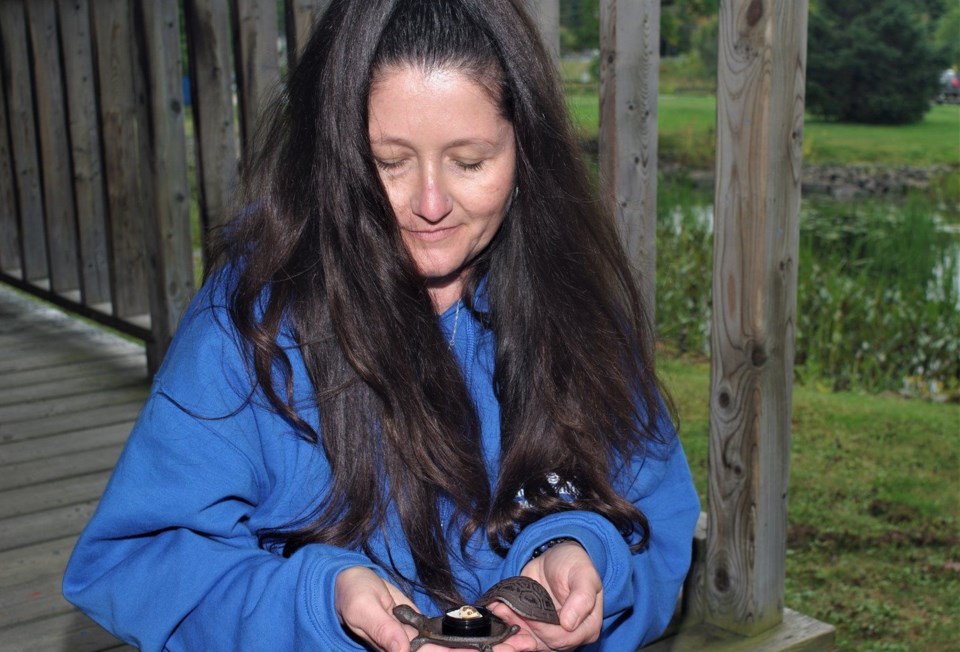Magnetawan is back with its geocaching program after its inaugural year in 2022 was well received by local residents and tourists.
Geocaching is a worldwide global activity where people use GPS on their mobile devices to find small objects hidden outdoors. The GPS provides the coordinates, and using those coordinates people make their way to the general site. Once there, just like in a treasure hunt, people search in a small area looking for the hidden object or cache.
Deputy Clerk Laura Brandt said the Village introduced the relatively new activity last year at the suggestion of one of its summer students. Brandt bought and hid nine geocaches last year and will add four more to the mix this year. She is the only person who knows what all the geocaches look like and exactly where they are.
Brandt says a geocache can be almost anything like a small ring, a figure, or even something as simple as a rock. Considering the activity was well received last year, Brandt believes it will be popular again this year.
Brandt places the geocaches close to tourist attractions in the community. Those sites include tiny logs where geocachers can add their name and where they are from once they find the geocache. In looking at last year's logs, Brandt knows the activity caught on because some locations indicate they were visited 40 times.
Brandt says if people set out to find all the geocaches it will likely take up to an hour now that the number of geocaches is at 13.
Some people are serious about the activity as Brandt learned last year when several Toronto residents came up for the day just to find the original nine geocaches. Brandt says visits like that are good for the community because it means the tourists are also taking in some sites.
When geocachers look and find a geocache, the general rule is that it's left behind unless you plan to replace it with another trinket for the next person to find. But Brandt says there is another form of geocaching where the trinket is intentionally taken and moved to another town or city then found again and relocated to another community. This is travel bug geocaching.
Brandt bought six travel bugs in 2022 and hid them in the general area.
“These travel bug geocaches have certain objectives,” Brandt said. “For example, one objective might be to get a travel bug geocache to a waterfall or to a point in Western Canada. Geocachers will make that happen because one person will pick it up and move it along for the next person to find it and again move it further along”.
One of Brandt's travel bugs was hidden on Midlothian Road in Ryerson Township.
The goal was to move it to another province and since being 'planted' last year it has moved 2,107 miles and is currently in Alberta.
Another travel bug was placed at a site on Old Nipissing Road which is a historic road and the objective with this cache is to get it to another historical site. Brandt said a geocacher found it and is in the process of relocating it.
She adds another geocacher found a travel bug at Whalley Lake in Magnetawan and is in the process of getting it to another town or city which is this travel bug's objective.
A travel bug hidden at the Knoepfli Falls in Magnetawan has moved 122 miles and is near Orangeville with the goal to relocate it to another waterfall. Brandt says Harry the Heritage Turtle used to be located at the Heritage Museum Centre and his journey was to get him to any ocean. Harry has only moved 108 miles and is currently calling the Minesing Wetlands near Utopia, Ontario home.
The sixth and final travel bug is currently near London Ontario.
This travel bug started from the Magnetawan Friendship Centre and the goal is to find it a new home with a friendly theme. Brandt gets an email each time one of the travel bugs is relocated and it's how she keeps track of all their movements.
The travel bug caches aside, Brandt says the sites for the nine local geocaches will remain the same as last year. She expects to hide the four new geocaches in June.
Brandt says the geocaching community communicates among itself and although she promotes geocaching on social media, it's geocachers talking among themselves that also helped promote the local program “to gain the momentum it now has”.
Brandt says because not everyone knows what geocaching is, there is the chance someone might accidentally come upon a local geocache. However to safeguard its removal, each site includes a small note stating what the person has found and if they are not a geocacher, they are asked to leave it where it is because people play the game to find the trinkets.
Rocco Frangione is a Local Journalism Initiative reporter who works out of the North Bay Nugget. The Local Journalism Initiative is funded by the Government of Canada.



